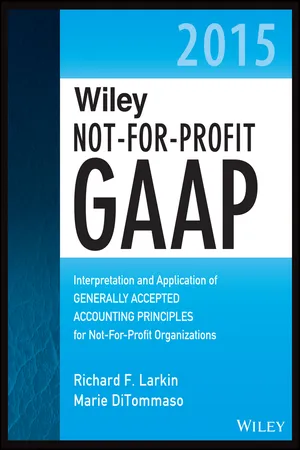
Wiley Not-for-Profit GAAP 2015
Interpretation and Application of Generally Accepted Accounting Principles
- English
- ePUB (mobile friendly)
- Available on iOS & Android
Wiley Not-for-Profit GAAP 2015
Interpretation and Application of Generally Accepted Accounting Principles
About this book
Wiley Not-for-Profit GAAP 2015 is a thorough examination of the authoritative standards for measurement, presentation, and disclosure as applied to not-for-profit organizations. Clear and concise, this user-friendly guide explains the fundamentals of GAAP in an easily-accessible format that includes flowcharts and diagrams to help facilitate the reader's understanding of the material presented, including a financial statement disclosure checklist to confirm GAAP adherence. Designed specifically for accountants in public practice and industry, this guide covers all relevant FASB and AICPA guidelines, to provide a complete reference tool for auditors who need a comprehensive understanding of GAAP for not-for-profit organizations.
Due to these organizations' unique characteristics, not-for-profit accountants must adhere to specific Generally Accepted Accounting Principles. These requirements are complex and ever evolving, but Wiley Not-for-Profit GAAP 2015 brings them together in a single volume that contains the most up-to-the-minute information available.
- Refine basic financial statements, including Financial Position, Activities, and Cash Flow
- Tackle not-for-profit-specific issues like fundraising, noncash contributions, affiliations, and pledges
- Tailor accounting methods to the specific type of organization, with budgeting, tax reporting, and regulatory advice
- Discover how general accounting topics like assets, mergers, and liabilities are applied to not-for-profit organizations
Preparers and auditors of not-for-profit accounts must stay up-to-date on the latest GAAP practices to best serve the organization, while complying with all disclosure, reporting, and regulatory requirements. Wiley Not-for-Profit GAAP 2015 provides extensive coverage and practical advice on the latest GAAP, tailored to the not-for-profit organization's unique needs.
Frequently asked questions
- Essential is ideal for learners and professionals who enjoy exploring a wide range of subjects. Access the Essential Library with 800,000+ trusted titles and best-sellers across business, personal growth, and the humanities. Includes unlimited reading time and Standard Read Aloud voice.
- Complete: Perfect for advanced learners and researchers needing full, unrestricted access. Unlock 1.4M+ books across hundreds of subjects, including academic and specialized titles. The Complete Plan also includes advanced features like Premium Read Aloud and Research Assistant.
Please note we cannot support devices running on iOS 13 and Android 7 or earlier. Learn more about using the app.
Information
Part 1
Overview of Not-for-Profit Organizations
Chapter 1
Overview of Not-for-Profit Organizations
- Perspective and Issues
- Key Differences between Not-for-Profit and Profit Organizations
- Resource Use Consideration
- Generally Accepted Accounting Principles
PERSPECTIVE AND ISSUES
- They receive contributions from significant resource providers who do not expect a commensurate or proportionate monetary return.
- They operate for purposes other than to make a profit.
- There is an absence of ownership interests like those of business enterprises.
- Keeping financial records;
- Preparing accurate and meaningful financial statements;
- Budgeting and anticipating financial problems;
- Safeguarding and managing the organization's financial assets;
- Complying with federal and state reporting requirements.
Table of contents
- Cover
- Title Page
- Copyright
- Preface
- About The Authors
- Not-for-Profit Accounting Literature
- Part 1: Overview of Not-for-Profit Organizations
- Part 2: Basic Financial Statements
- Part 3: Specific Not-for-Profit Accounting Topics
- Part 4: Other Accounting-Related Not-for-Profit Topics
- Part 5: General Accounting Topics Applied to Not-for-Profit Organizations
- Appendix: Disclosure Checklist
- Index
- End User License Agreement